Over the past 17 years, I’ve had lots of seat time driving trucks and SUVs off road. From local trails in Oregon or yearly trips to Moab, to driving remote routes in Canada or F-Roads in Iceland, I feel like I know a thing or two about 4WDs. Admittedly, when it comes to UTVs, however, I haven’t had much experience.
In fact, the last significant side x side seat time I had was 13 years ago in Moab. Since then, the UTV market has changed a lot. The performance has increased, the capability has gone up, and there are more features (and cost).
But recently, I went with Yamaha to Colorado to drive the 2024 Wolverine RMAX2 1000 and I got two days’ worth of experience with their side x side. Oh, and I did it on some of Colorado’s world-class off-highway vehicle trails.

We staged out of Taylor Park Trading Post, 23 miles northeast of Almont, Colorado. This property is composed of cabins and RV sports and is popular with UTV enthusiasts looking to explore the area. Located at 9,400’ in elevation, the air is thin but crisp, and the mountain vistas are gorgeous.
Wolverine RMAX2 1000 Engine, Driveline, and Utility
Before hitting the trail, I was briefed about Yamaha’s 2024 Wolverine RMAX 1000 UTV, both the Limited Edition and the XT-R variants. These vehicles feature a DOHC 999cc parallel twin engine mated to Yamaha’s Ultramatic CVT with engine braking. (This transmission also has an industry-leading 10 year warranty on the belt.)

The transmission has high and low gearing, and the vehicle has 2WD, 4WD with a limited-slip front, or 4WD with a locked front. The rear has a spool and is always locked. It also has three drive modes: sport, trail, and crawl. Each mode alters the throttle input, but still yields full giddy-up when needed.
Despite its recreational focus, this UTV keeps the U in utility task vehicle. This includes a tilting dump bed with a 600 lb. capacity and a 2” receiver with a 2,000 lb. tow rating. There’s also a standard WARN VRX 45 winch with a 4,500 lb. pulling capacity—great for moving objects around the property or self-recovery if stuck.
Automotive-Inspired Cockpit
Open the RMAX2’s doors and you have an automotive-inspired cockpit with two seats (an RMAX4 four-seater is available) with adjustable three-point seatbelts, a grippy ergonomic steering wheel, soft touch points, as well as a useful full-color Adventure Pro tablet by Magellan.

This unit, which is removable, allows occupants to view a variety of info including navigation with over 115,000 pre-loaded trails, engine information, elevation, and more. There’s also a factory stereo with Bluetooth connectivity and even an optional subwoofer.
XT-R vs Limited Edition
While the Limited Edition and XT-R models look nearly the same, there are a couple of differences. There are various colors and graphics. Although both ride on aggressive 30” Maxis Carnivore tires, the XT-R includes 14” bead lock wheels; the Limited Edition doesn’t.

They both have adjustable FOX 2.0 shocks with 14.2” of travel up front and 16.9” of travel out back. However, only the Limited Edition gets the advanced iQS (Intelligent Quick Switch) Suspension providing on-the-fly electric three-way damping adjustment. The XT-R’s shocks must be manually adjusted.

To The Trails
After a driver’s meeting, we hit the trails—arguably, some of the best in the U.S. Flanked by towering peaks, we were bound to have epic Rocky Mountain scenery the entire trip.
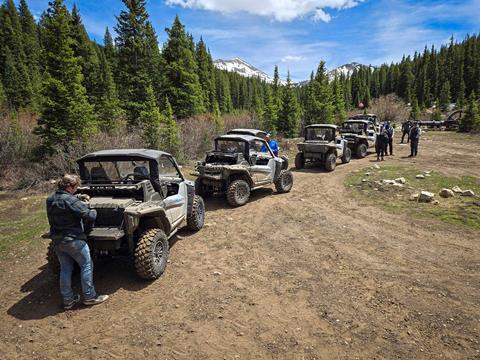
Our first leg took us down winding dirt trails and along a swift-moving creek gushing with springtime snowmelt. There were a host of turns and curves, plus straits where I could get a feel for the vehicle’s powerband and throttle response. The RMAX2 1000 isn’t the most powerful UTV on the market (no turbo on this one). However, it felt stable and planted, even at speed.
Remarkable On Rugged Terrain
Before long the trail got rocky, narrow, and treelined. There were many rounded, medium-sized rocks jutting from the ground. If I were in my own 4x4 SUV, we’d probably have to go about half to three-quarters the speed I could go in the Wolverine.
This is one of the amazing things about UTVs. They have the ability to cross rugged terrain at speeds faster than most trucks or SUVs. This is due to their fully independent suspension with lots of travel, relatively light weight, and more compact size.

I didn’t want to get too far behind, so I picked up the pace to keep up. Even over all these rocks, the Wolverine didn’t flinch. Another person in our group suggested adjusting my shocks from 2 (medium) to 1 (soft) for the bumpy terrain. This made a marked difference in ride comfort over the rocks.
As the terrain became more challenging, I switched from Trail mode to Crawl mode, put the transmission into low, and locked the front differential to see how it’d handle the rocks. The combination provided excellent off-road capability with plenty of precise control in the rough stuff. Eventually, we’d hit our maximum elevation: 11,473’.
Living Out a Rally Car Fantasy
Later in the day we’d encounter faster, smoother trails, so I switched to Sport mode. This provided impressive throttle response and a sportier experience.
Halfway through day one, I was becoming familiar with the Wolverine RMAX2 1000’s performance. I added left-food braking to keep my speeds up in turns, became comfortable with how the suspension would react over large dips and bumps, and got used to the four-wheel disc brakes’ stopping power.

Holy smokes, this thing was fun. I felt like I was living some sort of rally car fantasy. Full throttle, but with a big bump ahead. Hard brake with the left foot then throttle out. Tight corner, slow down, apex, and back on the gas—trees whizzing by, slight Scandinavian flick into the next corner, moderate throttle, then into a hairpin. It felt like I was in the World Rally Championship or some rally raid.
I wasn’t really going all that fast, but it felt like it. Frankly, I’m all about “slow car fast” driving as it’s so fun to be able to go full throttle without having to worry too terribly much about getting yourself into trouble. Most importantly, I needed to be safe, didn’t want to wreck, and wanted to ensure I was still treading lightly.
We got back to camp I couldn’t wipe the grin off my face. Hot damn, that was fun—and we get to do it again tomorrow.
Day Two Started with a Wild Water Crossing
We’d been told there would be a deep water crossing right off the bat on day 2. Ok, but how deep is deep?
Once at the creek crossing, we lined up single file. The trail leader, Pat, a Yamaha employee for 25 years, said he’d go across first in his modified Wolverine RMAX4 1000 to ensure it was still doable. A couple of minutes later, he radioed with the go-ahead. He said to “aim upstream” as we crossed so we didn’t get taken by the current.

I watched others go through first; the water was about 3.5-feet deep. I put my RMAX into low gear and started across the body of water. A bow wave formed in front of my vehicle as I mashed the throttle. Water flowed in through the doors and began accumulating in the footwells. (I’m glad I was wearing my waterproof Vasque boots!) The swift current began to take my rig downstream; I’d better aim farther upstream.
Eventually I drove out of the water, stopped, opened my door, and water poured out. Thankfully, the RMAX2 1000 has removable drain plugs in the floor to let the water drain. This was the deepest water crossing I’d ever done. I began to wonder where the engine’s air intake was. Pat informed me it was under the hood toward the top. If the water had been a few inches deeper, it might not have been doable.

There were several other water crossings, although none as deep as the first, and lots of muddy holes. Our Wolverines had optional folding windshields ($481.99 upcharge) made of polycarbonate. I kept mine upright and was judicious about wiping the mud off with a microfiber cloth and water for optimal visibility. The windshields are hard coated so we didn’t have to worry about scratching them. Good thing, because we saw plenty of mud, dirt, and dust.
Impressive Durability
En route to our lunch stop, we went up in elevation again to nearly 11,000’. The steep, rocky trail had lots water running down it, making it feel like we were driving up a waterfall. I was continually impressed with the Wolverine’s durability. There weren’t any broken shock mounts, sway bar end links, tie rods, tire punctures, or anything—and I wasn’t easy on it. Yamaha explained they put these vehicles through a litany of durability tests, and I believe it.
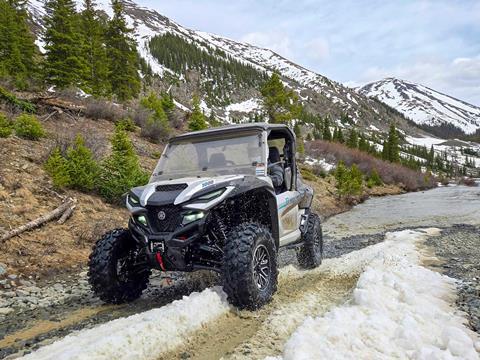
After lunch we descended the stream-like trail, and onto another track taking us to the base of Flagpole Mountain. The scenery looked like something out of The Sound of Music. I could’ve stayed here all day and stared at the incredible Colorado scenery. Alas, we needed to get back to camp.
Predictable Performance
As we sped down the trail back to camp, I thought about something one of the Yamaha employees said about the Wolverine RMAX2 1000: it was predictable.

Not once did this UTV get squirrely or do something unexpected. It had excellent steering, a very good suspension system and chassis, and it handled like I wanted it to. And, as someone who’s accustomed to road-going trucks and SUVs, I was highly impressed with this vehicle’s capabilities and ability to quickly traverse rough trails.
My Wish List
There were things that took getting used to or I wish I’d had during my two days with the rig. One thing was a lack of side mirrors. I’m used to having them on a road-going vehicle, and I was constantly looking for them. It would also have been great to have a four-point harness to better hold me in place when off-roading or hurtling down trails. Despite the fact the three-point belt was adjustable, it also dug into my left collar bone.

The good news is both are available accessories from Yamaha. While I found the seat itself comfortable enough, more bolstering would’ve been nice during cornering too, but that’d require turning to the aftermarket.
RMAX2 1000: Performance and Utility
The Wolverine RMAX2 1000, especially in XT-R or Limited Edition trim, offers an attractive mix of recreation and utility for those who enjoy riding but also may want to get some work done. It was also a great return to UTVs for me, thanks to its predictability and capability.

There are scads of accessories from Yamaha (and the aftermarket) to help make the vehicle exactly how buyers might want it. The Wolverine RMAX2 1000 XT-R starts at $26,460.99; the Limited Edition starts at $26,699.
At the end of the trip, we had a great meal of fajitas made by Chef Biju Thomas, some cold drinks, and plenty of stories to share around the campfire. Exploring the trails around Almont and west-central Colorado was marvelous, and our tool for exploration, the Yamaha Wolverine RMAX2 1000, proved to be an excellent choice for this Rocky Mountain adventure.
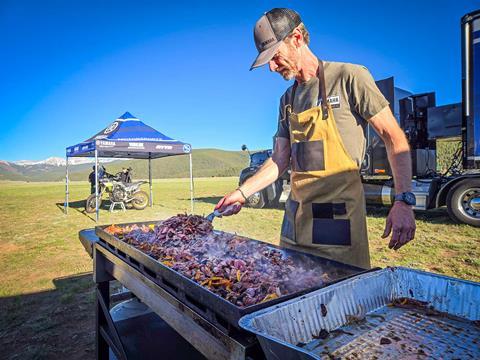
Access More Great Stories!
For more informative articles like this, consider subscribing to OVR Magazine in print or digital versions here. You can also find the print edition of OVR at your local newsstand by using our Magazine Finder.





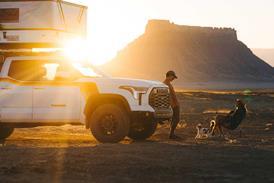
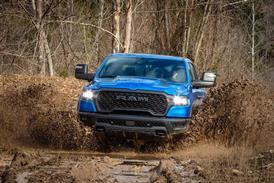







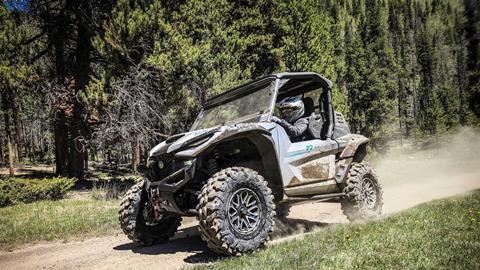






No comments yet